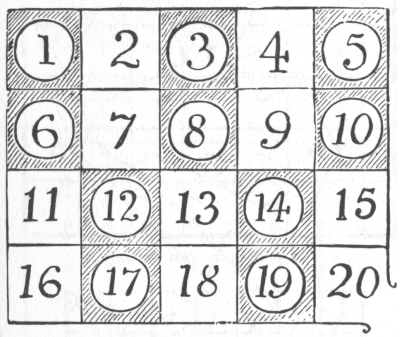
THE GREYHOUND PUZZLE.—solution
There are several interesting points involved in this question. In the first place, if we had made no stipulation as to the positions of the two ends of the string, it is quite impossible to form any such string unless we begin and end in the top and bottom row of kennels. We may begin in the top row and end in the bottom (or, of course, the reverse), or we may begin in one of these rows and end in the same. But we can never begin or end in one of the two central rows. Our places of starting and ending, however, were fixed for us. Yet the first half of our route must be confined entirely to those squares that are distinguished in the following diagram by circles, and the second half will therefore be confined to the squares that are not circled. The squares reserved for the two half-strings will be seen to be symmetrical and similar.
The next point is that the first half-string must end in one of the central rows, and the second half-string must begin in one of these rows. This is now obvious, because they have to link together to form the complete string, and every square on an outside row is connected by a knight's move with similar squares only—that is, circled or non-circled as the case may be. The half-strings can, therefore, only be linked in the two central rows.

Now, there are just eight different first half-strings, and consequently also eight second half-strings. We shall see that these combine to form twelve complete strings, which is the total number that exist and the correct solution of our puzzle. I do not propose to give all the routes at length, but I will so far indicate them that if the reader has dropped any he will be able to discover which they are and work them out for himself without any difficulty. The following numbers apply to those in the above diagram.
The eight first half-strings are: 1 to 6 (2 routes); 1 to 8 (1 route); 1 to 10 (3 routes); 1 to 12 (1 route); and 1 to 14 (1 route). The eight second half-strings are: 7 to 20 (1 route); 9 to 20 (1 route); 11 to 20 (3 routes); 13 to 20 (1 route); and 15 to 20 (2 routes). Every different way in which you can link one half-string to another gives a different solution. These linkings will be found to be as follows: 6 to 13 (2 cases); 10 to 13 (3 cases); 8 to 11 (3 cases); 8 to 15 (2 cases); 12 to 9 (1 case); and 14 to 7 (1 case). There are, therefore, twelve different linkings and twelve different answers to the puzzle. The route given in the illustration with the greyhound will be found to consist of one of the three half-strings 1 to 10, linked to the half-string 13 to 20. It should be noted that ten of the solutions are produced by five distinctive routes and their reversals—that is, if you indicate these five routes by lines and then turn the diagrams upside down you will get the five other routes. The remaining two solutions are symmetrical (these are the cases where 12 to 9 and 14 to 7 are the links), and consequently they do not produce new solutions by reversal.
click here to go to my blog.
See more interesting puzzles at http://puzzles.50webs.org